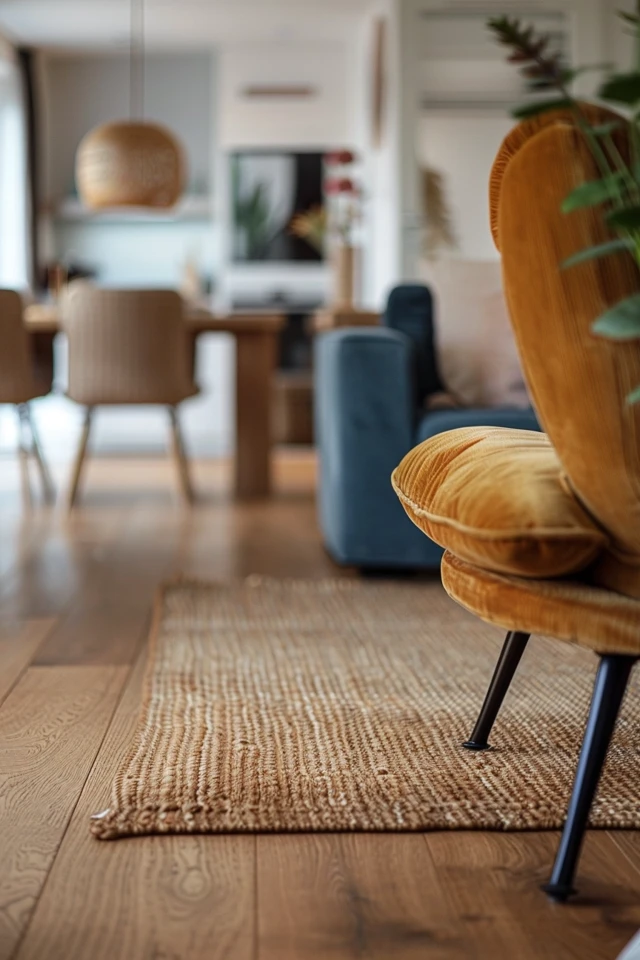Welcome to my guide on how to effectively match your hardwood floor with your home decor. The beauty and versatility of wood floors make them a popular choice for homeowners across various styles and designs. However, selecting the right color scheme and coordinating your flooring with your existing decor can be challenging. In this article, I’ll provide you with valuable tips and ideas to help you seamlessly blend your hardwood floor with your home’s aesthetic.
Key Takeaways:
- Consider the undertone of your wood flooring to determine which colors complement it.
- Incorporate a variety of materials in your furniture and accessories to balance the look.
- Area rugs can add comfort and enhance the visual appeal of your wood floors.
- Embrace diversity and mix different stains and grains for a collected-over-time look.
- Contrast the hard surface of wood floors with softer fabrics and textures.
Tips for Matching Wood Floors with Furniture
When it comes to coordinating your wood floors with furniture and decor, paying attention to the undertones is key. By understanding the underlying tones of your wood flooring, you can create a cohesive and visually pleasing space. Here are some tips to help you achieve a harmonious look:
- Match warm-toned floors with warm-toned pieces: If your wood floors have yellow, orange, or red undertones, consider choosing furniture and decor in complementary warm tones. This can create a cozy and inviting atmosphere in the room.
- Pair cool-toned wood with a variety of colors: If your wood flooring has gray undertones, you have the flexibility to experiment with a wide range of colors. Cool-toned wood pairs well with both neutral and bold hues, allowing you to create a modern and versatile space.
- Add contrast for visual interest: To create a visually appealing room, consider adding contrast between your wood floors and furniture. For example, if you have dark wood floors, opt for lighter wood furniture or vice versa. This contrast adds depth and intrigue to the space.
- Mix textures for added dimension: In addition to contrasting colors, mixing textures can also enhance the overall look. Consider incorporating different materials like leather, metal, or fabric to add visual interest and depth to the room.
- Consider the weight of the room: The weight of the furniture should be considered in relation to the color and tone of the wood floors. Lighter floors can be paired with delicate furniture, while darker floors can handle heavier pieces without overwhelming the space.
To further enhance the aesthetic appeal, don’t forget about smaller decor items. Pillows, blankets, rugs, and wall decorations can all add flair and tie the room together.
By following these tips and playing with colors, contrast, and textures, you can create a cohesive look with your wood floors, furniture, and decor. Remember to trust your instincts and have fun with the process!

Pros and Cons of Matching Flooring Throughout the House
When it comes to flooring, there are two main approaches: matching and mixing and matching. Let’s explore the pros and cons of each to help you make an informed decision for your home.
Matching flooring throughout the house creates a cohesive and seamless look. It gives your home a sense of continuity, making it visually appealing and unified. With matching flooring, you don’t have to worry about different materials or colors clashing, creating a harmonious flow from room to room. Additionally, cleaning becomes a breeze, as there are no transitions or transitions to disrupt the flooring surface.
However, one drawback of matching flooring is that it can lack creativity and diversity. It may limit your options when it comes to design choices and may not allow each room to have its own unique character. If you prefer a more eclectic or personalized look for your home, matching flooring may not be the best choice.

On the other hand, mixing and matching flooring offers more flexibility and customization. You can choose different flooring materials, colors, and styles for each room, tailoring it to suit the specific needs and aesthetic preferences of that space. This approach allows for easier repairs, as you can replace or modify individual sections without needing to redo the entire floor.
However, mixing and matching flooring can result in a less cohesive overall look. It may not create a seamless transition from room to room, especially if you have an open floor plan. Additionally, it requires careful consideration and planning to ensure that the different flooring choices complement each other and create a visually pleasing result.
In the end, the choice between matching and mixing and matching flooring depends on your personal preference and the desired look of your home. Both options have their pros and cons, and there are no hard and fast rules. Whether you prefer a cohesive and seamless design or a more eclectic and diverse look, both can result in a beautiful and coordinated space.


